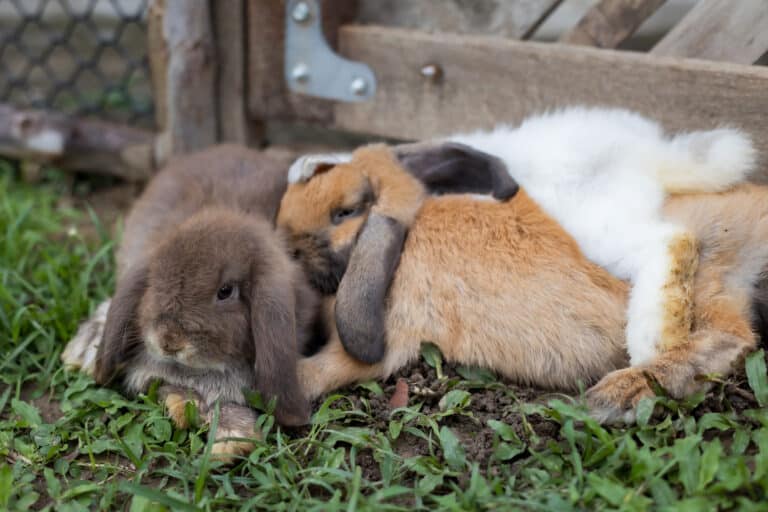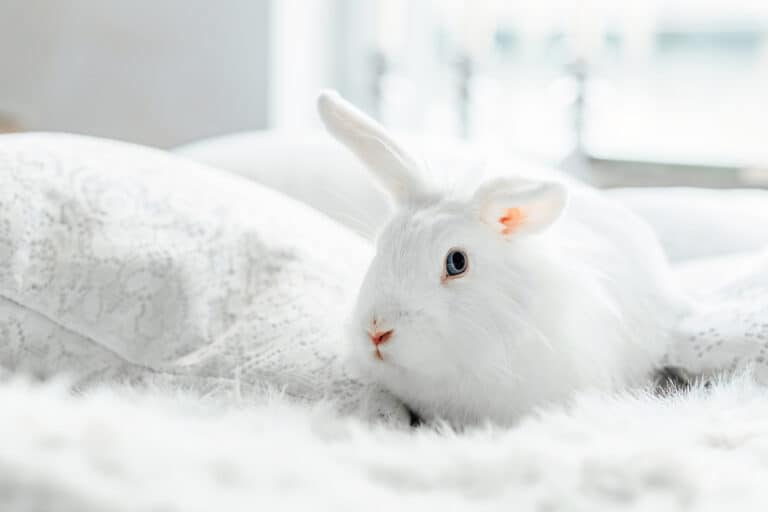Angora Rabbit Facts [Updated 2022]

The Angora rabbit is arguably one of the most distinctive among so many bun breeds. That’s due to its long, flowing locks that make it look like a ball of fluff. Prized for their lovely wool, these rabbits also make excellent companions. Want to know more about them? Here are some Angora rabbit facts that can help you decide if they’re the breed for you.
History of the Angora Rabbit
The Angora rabbit originated in Ankara, Turkey. With a history that some claim goes back 1000 years, it’s considered one of the oldest bun breeds. When the rabbits came to the U.S. in the 1930s, they were classified under one type: the Angora Wooler. Later on, the Angora Wooler got divided into two distinct breeds, the French Angora and the English Angora. Mixing these two Angora types with other breeds led to new Angora classifications.
There are 11 kinds of Angora rabbit, but the American Rabbit Breeders Association (ARBA) recognizes only four.

General Appearance and Characteristics of the Angora Rabbit
When it comes to looks, Angora rabbits stand out, what with their luxuriously thick and silky coat. They usually weigh around 5-10 pounds, have a compact body with a flat, broad head and short ears.
Angoras usually live for about 7-12 years.
Coat
Thick, fluffy, and silky, that’s the typical description for an Angora rabbit’s coat. In some types, the thick wool covers almost the entire body, including the ears and feet. That’s why an Angora bun looks like a fluffy furball. The coat comes in a range of colors, depending on the Angora’s type. The most common hues are black, blue, white, chocolate, black tort, blue tort, and chestnut.
Although most Angoras molt or shed their fur like other rabbit breeds, some don’t. As such, these breeds need shearing.
Temperament
Angora rabbits have a sweet and gentle nature. Their mild temperament makes them wonderful animal companions. However, don’t expect them to bond with you immediately. Angoras tend to be shy at the outset, and they need time to adjust to new people and surroundings. Sudden noises may spook them, so to keep them calm, we advise interacting with them using a soft voice. Once they’ve gotten to know you, though, they will look forward to your company and will even snuggle against you when given the opportunity.
As gentle as they are, they can become aggressive when frightened. Angoras also don’t particularly appreciate being picked up, so give your pet time to get used to being held.
Health
Given proper care, Angora rabbits live a long and healthy life. Still, they can develop breed-specific health conditions. Those issues are primarily associated with their dense, fluffy coat.
These health problems include the following:
- Overheating or heatstroke: Rabbits can overheat when the weather is too warm. Due to the Angora’s thick coat, they may have more trouble regulating their body temperature than their short-haired counterparts. Keep your Angora rabbit out of the sun and groom him regularly to keep him cool, especially during summer.
- Wool block: Also known as hairball, this condition commonly occurs during molting season. As rabbits groom themselves, they tend to swallow a lot of hair that can get trapped in their digestive tract and lead to wool block. Rabbits can’t cough up or vomit the ingested fur, so the hairball can get bigger and bigger until it causes a blockage. Note that wool block can be fatal to rabbits if not addressed immediately.
- Flystrike: The Angora’s long coat is prone to matting. Matted fur can attract flies, which lay their eggs on the rabbit’s coat. When the eggs hatch, the larvae feed on the bun’s tissues. This health issue, called flystrike, is distressing and extremely painful to rabbits.
- Cheyletiellosis: This is also referred to as Walking Dandruff and is caused by a rabbit fur mite called Cheyletiella Parasitovorax. While this condition occurs in many rabbit breeds, the long fur of Angora buns makes them more susceptible to attracting the parasites that cause Cheyletiellosis.

Grooming Requirements
As you can probably guess, Angora rabbits need plenty of grooming. Brushing 2 to 3 times a week is a must and needs to be increased during molting season. Regular visits to the groomer (around 4 times a year) should also be a part of your routine if you want this rabbit breed for a pet. The groomer will give your bun a “puppy cut,” which involves shearing most of the fur from his body and face but leaving the feet and ear coat relatively long.
Types of Angora Rabbits
Although there are several Angora rabbit classifications, only 4 have gotten the recognition of the ARBA. Let’s take a look at these types.
English Angora Rabbit
This is the wooliest among the Angoras. Almost all parts of this bun’s body are covered with fur. Its docile nature makes it a great pet but is not advisable as a companion for those who have little time to groom their fur baby. With a weight of around 5-7 pounds in adulthood, this bun type is the smallest among the Angora rabbits.
French Angora Rabbit
Unlike the English Angoras, who are almost entirely covered with fur, French Angora rabbits have no long facial hair and only little fur covering on the legs. They tip the scales between 7 and 10 pounds, making them slightly larger than the English Angoras. Because of their fur texture, they don’t require as much coat maintenance as the English Angora rabbits.
Satin Angora Rabbit
Their soft, fine, and silky coat gave the Satin Angoras their name. They were created by breeding a French Angora with a Satin rabbit. Growing to a weight of around 6 ½ to 10 pounds, Satin Angoras make great pets. However, you’ll need to keep their fur free from tangles to protect them from wool block and flystrike.
Giant Angora Rabbit
Weighing between 9 1/2 and 10 pounds in maturity, Giant Angoras are the largest of this rabbit type. They were produced by crossing German Angoras with other large bun breeds, like the Flemish Giant. An interesting fact about the Giant Angora’s wool; it doesn’t shed naturally. Instead, it requires shearing or harvesting by hand.

Angora Rabbits are a unique breed. Their long, shiny coat makes them stand out among other bun types. Sweet and affectionate, they make wonderful companions as well. However, be prepared to invest a lot of time grooming your fur baby if you decide to welcome one into your home.
We hope you enjoyed reading these Angora rabbit facts and have learned something new about these lovable creatures.
We hope you enjoyed this post! If you did, will you give it a share or two 🙂 Thank you! ~from Every Bunny Welcome







